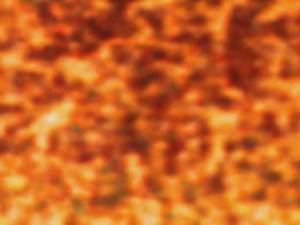
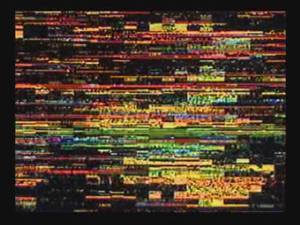

Bus Station in Detroit, by Kyle Canterbury Color Shifts, by Kyle Canterbury October 2006, by Kyle Canterbury
Kyle Canterbury is a videomaker and abstract painter who lives in central Michigan. He began working in video in 2005 and started completing works in 2006. His pieces are all short. Many are "abstract," and those with recognizable scenes also use abstracting elements. Almost all his works are silent. While some have found his work filmic, he does not use film in making it and has no intention of transferring it to film. In fact, when he made his 2006 work the only screens he could view it on were cathode ray tubes, either conventional TVs or a computer monitor, and I think it looks best on a CRT. It does come through OK in video projection and on LCD monitors. While his first sense that film could be a formally controlled art came a few years ago with his discovery of Orson Welles, and especially his Touch of Evil, not long after he discovered Stan Brakhage via the Criterion DVD set, and several who have seen his work find a connection to Brakhage. In 2006 he saw many of Brakhage's major films, and many other avant-garde and other films, on film. His tastes in cinema, painting, and classical music are quite close to my own, and in fact he feels that his work is inspired by classical music as early as Léonin, and by painting as early as van Eyck, as much as by film. Because Canterbury is a close friend, I do not claim critical objectivity, and do not plan to publish on his work without also disclosing that he's a friend. I do think I have a good record of being able to view friends' work as clearly as any other.
In my judgment, his best videos are truly original, astounding, great works of art. No one that I know has used video as he has. Early video artists used devices such as the Image Processor to produce various abstracting effects that are unique to video, but Canterbury's works deal with the video viewing situation, and particularly with the nature of video as seen on the cathode ray tube, the type of viewing that until recently was present in most every home. In this sense he is working in the great tradition of avant-garde filmmaking, in which the viewing process is addressed, often explicitly, in a way that makes the viewer more aware in the act of viewing. A central technique of Canterbury's work to date is to rephotograph his material as it plays on his computer monitor. Often he will rephotograph again and again, the result thus several generations removed from the photographed original. This process introduces pronounced flicker in a way that accentuates video's natural flicker, but it also reduces the definition of the original footage and increases one's awareness of the detailed texture of the image on the screen. Sometimes he reshoots only a tiny area of the screen, making the moving almost-organic shapes that make up the video image dominant.
In only a short time, and with limited tools — a consumer digital video camera, a PC that's a few years old, a small CRT monitor, and a very basic editing program — Canterbury has developed a repertoire of techniques that explodes the "black box" that video apparently represents for most makers, who have used it with a naive idea of transparency to produce what Brakhage used to call "pictures." I do not think it is too grand to declare that Canterbury has done for video something like what Brakhage has done for film. In his hands, after less than a year of work, this medium, which so many have found severely limited, has become as supple, as pliable, as sensuous, and as rhythmically various, as film was for Brakhage. Tiny details, multiple rhythms combined polyphonically, fragments of activity at the edge of the frame, tiny shifts in focus, and renditions of the fragmented vibrations of a monitor almost as if seen from the inside, all become colors in his palette, sounds of his ensemble — tools he uses with astonishing mastery. And, in the best tradition of film modernism, of Brakhage and Breer and Gehr, he has made video art that is self-aware, through exploring not only the manipulative possibilities of the medium but also the viewing situation itself, as the natural flicker of the video image is magnified by, and interacts with, the more visible flicker Canterbury introduces. Video flicker in his work is a complex mix of randomness, rather repetitive electrical-like vibrations, and controlled, even somewhat organic rhythms. A central tension that animates his work is that between these flicker rhythms and the other, different rhythms of his subject matter. And, in a wonderful example of artistic paradox, the ways in which Canterbury accentuates flicker, rather than ignoring it, as most videomakers do, can deepen one's seeing of the recognizable subject matter in his more representational pieces, because Canterbury's magnifying of flicker also allows the viewer to see past it as well.
Fred Camper
September 8, 2006.
All of the videos on this program were made in 2006. See the top of this page for a full list of the works that will be shown.
19: Passage
19: Passage followed a series of videos Kyle Canterbury made in April and May of 2006, "18 Videos," numbered 1 through 18, which were among his first released works. Like those, 19: Passage explores the dual possibilities of accentuating video flicker and video grain through rephotographing imagery off of a small portion of a cathode ray tube monitor.
One thing that is spectacular about 19: Passage is its irreducible collision between its static imagery of tiny squiggles of video "grain" — TV static that grows more enlarged as the camera gets closer to the monitor as the piece progresses — and the continuous movement provided by accentuated flicker. One intuitively wants the grain to move too, or the flicker to stop. Because neither happens, the work is riven by a double rhythm that accentuates the artificiality of video itself. Twice, near this work's midpoint, an abstracted anonymous face comes into focus. Startlingly affecting because of the unique suggestiveness of the human face and its presence amidst these abstracted and machine-like shapes and rhythms, it serves as a reminder of video's primary function in our culture — not only the purveying of representational imagery, but the purveying of emotions — as well as of the arbitrariness of video representation, constructed as it is out of the abstract points of color and scanning rhythms that commercial broadcasts try to efface. Just as the work seems to have come close to a translatable meaning along these lines with these faces, it veers off into greater abstraction, fuzzy fields of red alternating with an almost pure blue flickering screen, not only as a way of undercutting the translatable point but also as a way of opening out onto purer, more expansive visions.
Fragments from a Room
We see some fragments of a nondescript room — mostly walls. A white frame surrounds the image, and seems to be generating the whitish vertical flicker. White here stands not for purity, nor for any of its other traditional associations, but for the maximum color noise it actually is — a mix of all visible colors from which video, or film, must make selections. In that sense white is perfect as a generator of flicker, since flicker is itself another basis of video. A ladder sits in the center of the room, presumably because the room is being renovated, and we see a few glimpses of figures. At the point when several different juxtaposed views of the ladder seem to be constructing a kind of architecture, suggesting that the ladder is a metaphor for the artificial ordering of the room itself, we cut to some pale, gentle leaves out the window, also shifting focus on them.
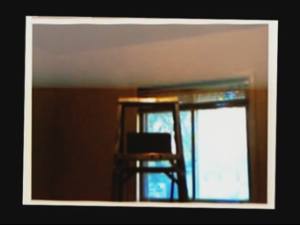
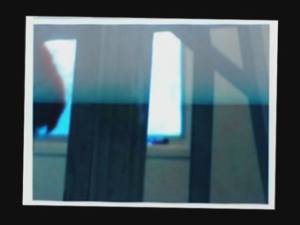
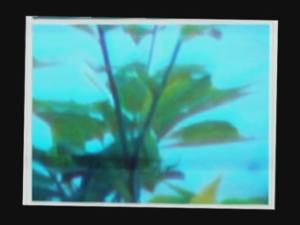
The leaves seem irreducible in the way that the ladder and room do not. This is nature, and however much it flickers, however much it's filtered through video, the plants evoke direct touch in a way the images of the room do not. As so often in his work, Canterbury juxtaposes apparently irreconcilable elements and experiences not with the effect of integrating or blending them but to make them stand out in their differences.
(July, 2006)
In the opening images of this exploration of an ordinary backyard, that of the artist's central Michigan home, a contrast is evident between two extremes: a video flicker less accentuated than usual in his work but still strongly evident in its mechanical, repetitive, almost spasmodic rhythms, and the organic movements of tree leaves in the wind. These two kinds of movement could not be more opposite, and that's how they are felt. Focus changes within several images appear to have a mediating effect, as if the artist is seeking to establish — and ultimately failing to establish, a failure that is part of this work's subject — a middle ground between these two irreconcilable extremes. This video is also structured as a montage journey, its compositions and editing also appearing to serve as an attempt to discover more of the backyard, but any dream of establishing an objective space fails as the images grow more enclosed and more enigmatic.
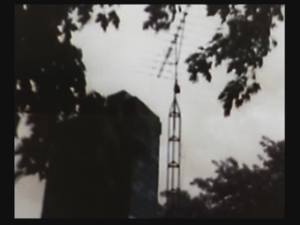
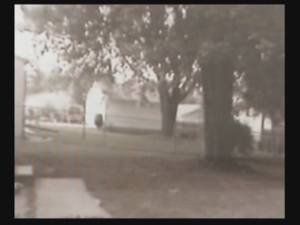
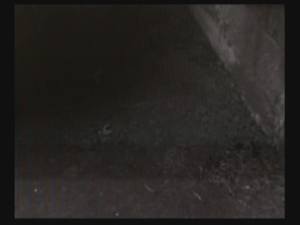
7 New Videos: #5
The contrast in this very short piece is between rapidly changing thick black forms that look like they might be at home in an abstract expressionist painting and a slower moving background that also looks like an abstract painting, but in paler shades of gray.
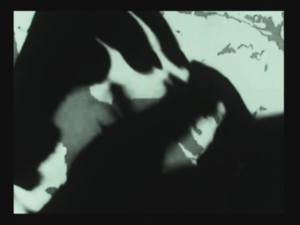
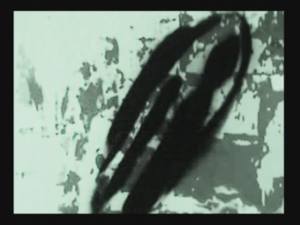
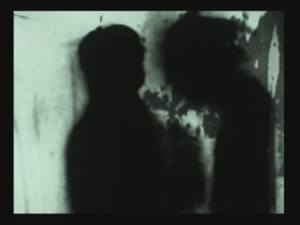
The black forms feel as if they are blocking our view of the "real" scene, until, in a sly and faintly humorous way, Canterbury mixes silhouettes briefly into the black abstractions, suggesting that it is we humans that are the "problem," the agents that block clear vision.
7 New Videos: #7
Here the contrast is between racing pinkish diagonal streaks that have the energy of open flames, or of a moving train, and a more static dark gray-black background that includes squares that are the artefacts of compressed digital video.

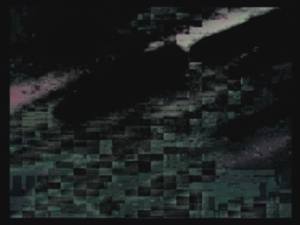
These two "fields" are sensed as quite different from each other; as is so often the case in Canterbury's work, they feel as if they come from whole different worlds, different ways of seeing and knowing and believing and being, offering a vision of an irreconcilably divided self — or of a self experiencing irreconcilable divisions in our media-saturated age.
10 Videos: 10
Enclosed in a white frame similar to that in Fragments from a Room, we see a series of backyard views through a window. As the focal length used in each image gradually increases, the window screen we are looking through gradually becomes more visible, until in two shots its black grid is at least as prominent as the scene outside, forming a perfect rectilinear mate to the intrusive vertical flicker — both screen and flicker have irregularities and are not precisely geometrical. In a paradox characteristic of Canterbury's work, the closer you try to get to an actual scene, the less you can see of it.
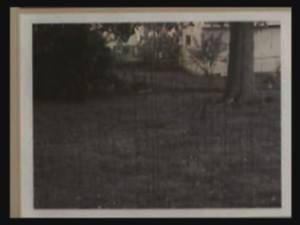
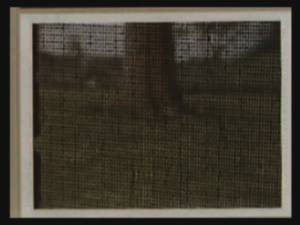
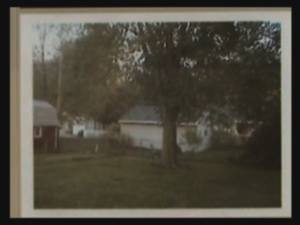
More generally, our hope of achieving palpable contact with the world must always be balanced by an awareness of our internal imprisonments in both personal subjectivity and the media that filter so much of experience. Then two final images are taken with a wider angle again, but the suburban scene now has an intense, almost claustrophobic awfulness that makes one long for the screen's imprisoning grid, whose details at least have dynamic variety. Ordinary houses become like monsters with a mood that recalls Stan Brakhage's vision of ordinary houses as hell in his Fire of Waters.
01
This begins with a starkly abstracted image that looks a bit like the curve of a river at the right of an otherwise black landscape. Most of this black and white image is dark; the white areas are the "river" and "sky." Then the brightness level starts changing: the "river" expands so that much of the screen is white, or disappears so that most is black.
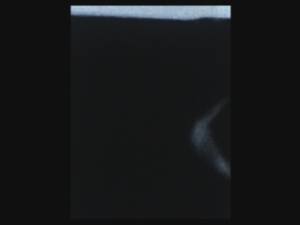
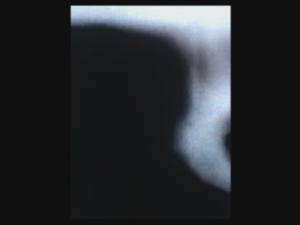
The image appears upside down, and then the work veers off into a series of unpredictable changes; shades of tan even appear. The effect is something like starting on a walk in the woods and soon becoming totally lost, and indeed I find this work a bit frightening. The image is also vertical rather than horizontal. The sides are masked so that the image is taller than it is wide, and this creates an intense feeling of constriction.
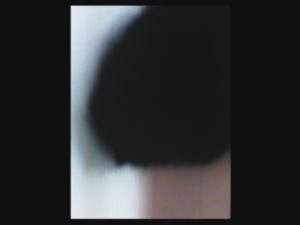
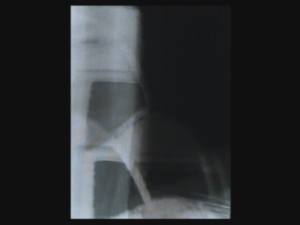
When the initial image reappears at the end, I suddenly felt as if I'd been through a musical theme-and-variations form that wandered especially far from the original "theme." The central idea, though, seems to be once again the utter arbitrariness of video representations: they can transform themselves almost totally just by the turning of a little dial or two, and the changes here feel as if they've been made that way.
Stan Brakhage once said that video can never be an "art" because of those little dials that allow the viewer to change the color. There are a number of things logically wrong with his claim. One is the varying color balances of the prints of the same film he let out into the world in his lifetime — when "off," they generally hurt the film, but much of its greatness usually survived. Another argument against Brakhage's statement can be found in the variety of performances of the same piece of classical music. A piece can indeed be destroyed by a terrible performance, but can also sustain its greatness through a variety performance styles. Still, Brakhage did have a point, in that the variety of monitor settings can alter the way a video appears. I really wish he had lived long enough to see Canterbury's work, which I think he would have loved. These ruminations seem particularly relevant to 01 in that, more than most of the other videos on this program, I think it would survive a wide variety of monitor settings and viewing situations, depending as it does on the rhythms with which its very schematic imagery transforms itself.
02
This begins by introducing several abstract forms, somewhat in the manner of Robert Breer's 69. A vertical slit of white enters from the left. A band of whitish noise rises vertically. Then an image of a vague dark oval shape with very faint colors around it appears, also flickering. These elements recur — the slit reappears superimposed over the oval — until, in a sharp break, a new element, rectangle of fine white lines against black, enters and then suddenly yields to a series of brighter, engulfing images. In one, the camera seems to be moving very close to the CRT monitor. Each of these feels like it continues far beyond the borders of the frame.
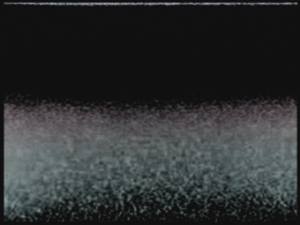
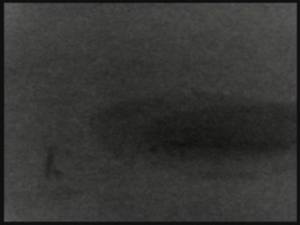
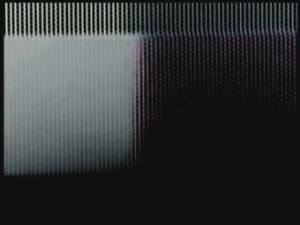
The nature of video has suddenly, explosively intruded into what had been a relatively controlled formal study. Video is an all-consuming monster here, as it is in our larger culture as well.
LX
The opening static image looks a bit like a trendy abstract painting hanging in front of the frosted glass blacks of some corporate lobby. It's clearly a video abstraction, though: the "painting" isn't mounted at all. After a few seconds, the geometrical designs in the painting begin to move, diagonals and triangles and polyhedrons continually transforming themselves.
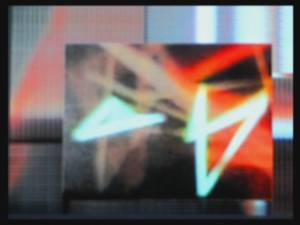
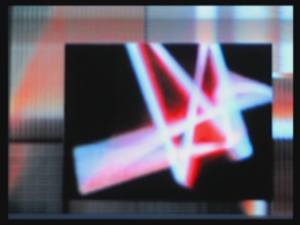
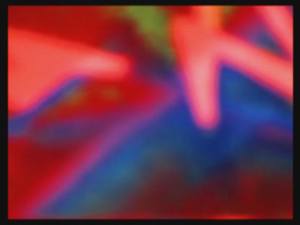
And after not too long, in another characteristic boundary-crossing moment, it feels as we are suddenly inside a small portion of the painting itself, surrounded by thickets of bright shapes in similar colors. If the opening setup gave the viewer a tentatively secure sense of self as a viewer separate from the image, the "boundary-crossing" undercuts fixed identity, the stability of the self. In the world of these videos, if the self is truly open to the sights and sound around, that self is also always threatened with obliteration.
Slowly Dreams
In some ways this is my own favorite, though I think my appreciation of it is greatly enhanced by having seen the earlier works. It's different, most obviously in being much slower. A series of "static" long takes of leaves, some in negative and largely drained of color, it also lacks the usual kinds of flicker.
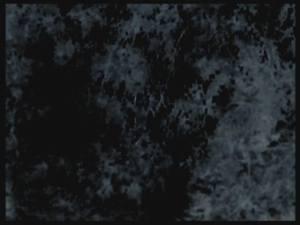
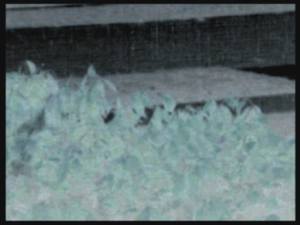

Instead, the tiny movements of video "grains" seem accentuated, as if at once magnified and slowed down. One views some almost motionless leaves with tiny flickering grain, and when a tiny shadow seems to pass over them for a fraction of a second it's a major event. There is, indeed, a meditative sensibility not unrelated to that of John Cage at work here, but with an added sense that at every moment, tiny bits of video grain and noise are fracturing the image and splitting apart time. The viewer is encouraged to focus on the "random" rhythms of video itself, which hardly feel random at all, and when the accentuation of video noise or grain seems to vanish in two similar shots with different tints, one finds oneself with a much keener awareness of the continually-moving aspect of the video surface. Unlike in many others, I did not feel an irreconcilable gap between the few events in the world that are seen and the rhythms of video. When in the final long take bicyclists and cars shoot by briefly in the background, it feels as if they somehow emerge naturally from the cosmic background noise of the video universe, as symbolized here by the tiny movements of video "grains."
Patrick Friel is the Program Director of Chicago Filmmakers. It is he who decided to offer Canterbury a one-person show after seeing his work. At the time the show was scheduled, Friel hadn't seen the last four videos on this program, which are the most recent, and I was especially interested in what he would think of Slowly Dreams. He liked it as much as I did, and the comments he wrote me I completely endorse: "Slowly Dreams is unbelievably great. Perhaps the best thing he's done. The delicacy and subtlety of motion in the frame is stunning....With this, I think, he has made video breathe."
Some Conclusions
Though certain aspects of Canterbury's work recall Brakhage, on a deeper level there are major differences, differences that help show Canterbury's uniqueness. These differences all relate to key aspects of Brakhage. Brakhage will combine diverse rhythms, and unpredictable shifts, but always seems to make of a continuous flow of these varieties. Brakhage profoundly acknowledges his use of the film medium, but his acknowledgements are balanced by a tendency to feel he can use it to capture, as he more or less once wrote, a little bit of the light of angels. For every element that asserts the film surface, there's another in Brakhage that suggest a passage through it. And Brakhage's great achievement of "personalizing" the cinema as a vehicle of individual vision resulted in films that express the qualities of his own consciousness, bodily rhythms, even "personality."
Canterbury's work accommodates sharp breaks in tone, in rhythm, in style, far more than Brakhage's does. There is less of an attempt to "integrate" diverse elements and more of an interest in keeping them together without eliding their differences, as in the case of seemingly incompatible rhythms. And Canterbury's work tends to assert that its own epistemological limits are those of the video medium, and that in fact what the video medium reveals most clearly is the nature of video itself. More than once he will structure a work as a journey, even apparently a journey outward, but instead the journey winds up leading even deeper into video. This potentially despairing theme also becomes liberating when, as happens so often, the tiny fragments of video itself make a kind of poetry, or music, or dance. Finally, Canterbury's work doesn't evoke "personality." The very stability of the self seems challenged, such as at those boundary crossing moments when, at the point the viewer begins to feel a bit stable in space and time, we plunge into some much more engulfing alternative one. Is there a self in these works at all, or have they become engulfed by video? Perhaps the point of the work is to leave that question open.
The first two qualities actually feed into the third, and create, for me, a feeling of vastness, vastness in space and vastness in possibility, that gives the best of Canterbury's work a "cosmos-embracing" feeling. Rather than projecting a self onto the world, there's an attempt to embrace all of what is -- understanding, all the while, that "all of what is" in a video may be delimited by the properties of this very non-transparent medium.
Fred Camper
January 11-14, 2007.


